of Phnom Penh
24 March 2008
Earlier I presented pictures of the beginnings of paving the street in front of the Deaf Development Programme, a process that will probably take months. There was another development when I arrived at DDP this morning at 8:00 AM. |
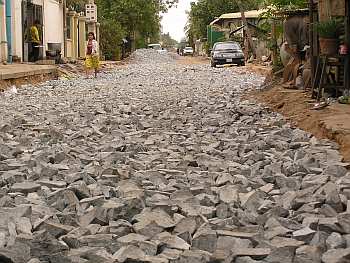 24 March 2008 Sometime over the weekend, the municipality spread rocks over the first 100 feet or so of Street 101 in front of the Deaf Development Programme. Why they didn't spread the other piles of rock the length of the street is anyone's guess. |
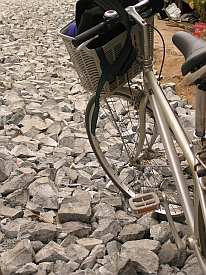
The problem is that these rocks are BIG rocks, 4" to 8" across. It is NOT gravel, and it is impossible to ride a bicycle across them. It is difficult even to walk across them. |
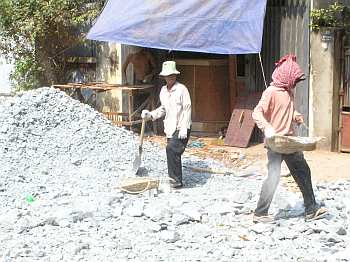 25 March 2008 Yesterday I wondered why the piles of crushed rock hadn't been spread along the length of the street in front of the Maryknoll Deaf Development Programme but only along the first 100 feet. Today I found out. The rocks are being spread by hand, by a small crew of women! |
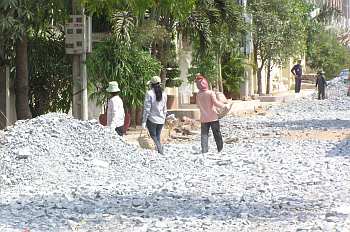 The women carry woven wicker baskets full of the crushed stone to various parts of the street. Apparently this is a sub-base for the road which will be covered by dirt again and then perhaps more rock and other paving materials. |
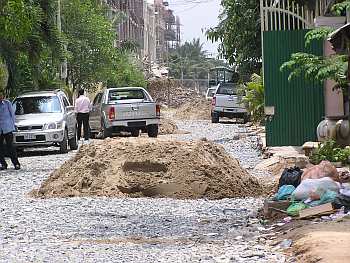 28 March 2008 Three days after the women spread the large rocks on the street by hand, truckloads of sand appeared one morning before I arrived at the deaf office at 7:45 AM. Notice there is little sensitivity to the needs of the residents of the street. The sand gets plopped almost in the middle of the street. |
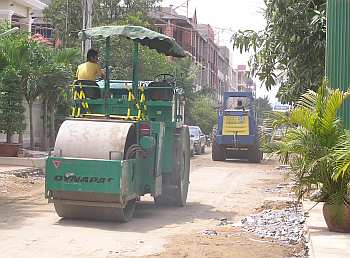 4 April 2008 The next day after the sand was dumped on Street 101, the little crew of women came again and spread the sand the length of the street by hand. Then these "steamrollers" came to roll over the large rocks and sand, and they have come back every other day. There is no visible effect of the rolling of the sand, but.... (Today what do you call these machines which were known as "steamrollers" when I was a kid? In India they call them "road rollers.") |
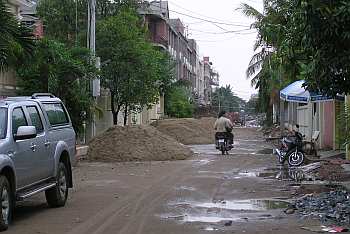 7 April 2008
|
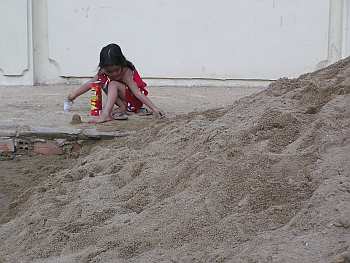 10 April 2008 The piles of sand have been in the street for almost five days now, and the passage of heavy trucks (the garbage truck and a low-boy flatbed carrying a bulldozer to a construction site) has left six or eight inches of loose sand across the street by each pile. In a country where people ride small motorbikes and bicycles, six inches of loose sand is a big problem. This little girl doesn't see it that way, though. |
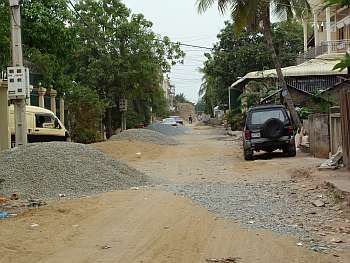 23 April 2008 The long-drawn out saga of the paving of Street 101 continues. Now truckloads of crushed rock have been dumped between the piles of sand that were dumped on the street almost two weeks ago. What will happen next? Will it be another two weeks before the next step in the paving? Or will the ladies with their wicker baskets come tomorrow to spread the rocks and sand around? What would be a simple one or two-day task in developed countries has already dragged on for almost two months. |
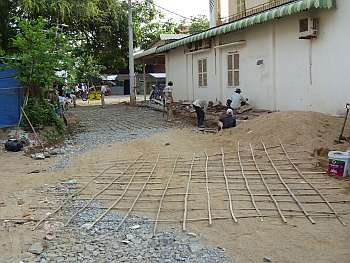 24 April 2008 Little did I know yesterday when I posted the picture of the new piles of rock that the street pavers would return today to start some actual paving! Of little consequence to the workers was the fact that our street is a dead-end because of construction of a new market at the other end of the block; they just started paving at the head of the street where it was sure to cause maximum disruption. Remember that our office alone has two classrooms of students who need to come in through the area where the paving started today.
|
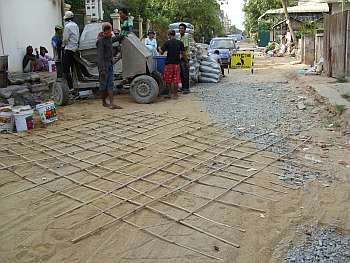 I saw a first in my experience of road paving today. In developed countries, I have seen paving companies create a grid of heavy rod or steel reinforcing bars ("rebar") which serves to stabilize and strengthen the concrete poured over the grid. Today the workers on Street 101 used a grid made of bamboo! [Maybe it's called "reboo"?] I wonder if it has any practical effect from an engineering point of view? The concrete was mixed in the portable mixer shown and then dumped along the street by women and children carrying buckets with metal hooks. |
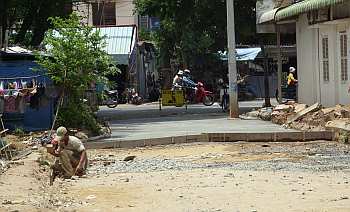 27 April 2008
|
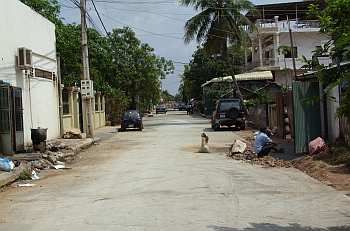 28 April 2008 And by the end of the second day, you could stand at one end of the block and see pavement all the way to the other end. The street is still far from finished--they need to put in curbs, openings to the sewers, etc.--but at least now we have a solid, uniform surface to replace the dust and mud and potholes of the past. |
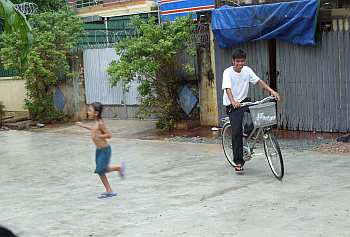 The concrete set relatively quickly and within a few hours the neighbors and one of our deaf students were enjoying their new street! I was surprised that there were not dozens of names written in the drying concrete but then most of the people are not literate so maybe there's little temptation to memorialize themselves as Westerners do. Actually one of the few mementos left in this drying concrete was a set of my own footprints. They were pouring 30-foot sections, one at a time, and when I left to go home this evening, I thought I was stepping into an earlier section that had already hardened. Where I stepped was only semi-solid, though, so there are four of my footprints where I made a quick angle toward the side of the road and firm ground. The concrete set relatively quickly and within a few hours the neighbors and one of our deaf students were enjoying their new street! I was surprised that there were not dozens of names written in the drying concrete but then most of the people are not literate so maybe there's little temptation to memorialize themselves as Westerners do. Actually one of the few mementos left in this drying concrete was a set of my own footprints. They were pouring 30-foot sections, one at a time, and when I left to go home this evening, I thought I was stepping into an earlier section that had already hardened. Where I stepped was only semi-solid, though, so there are four of my footprints where I made a quick angle toward the side of the road and firm ground. |
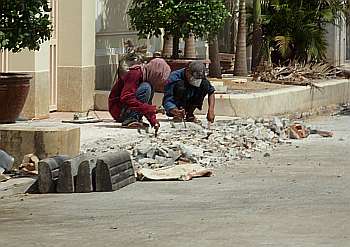 9 May 2008 The concrete was poured on Street 101 almost two weeks ago but not much has happened since then. Workmen have put curbs in front of a few houses but there seems to be no plan or order to their work. This house belongs to the head of the most exclusive international school in Phnom Penh so maybe he paid to get a curb. |
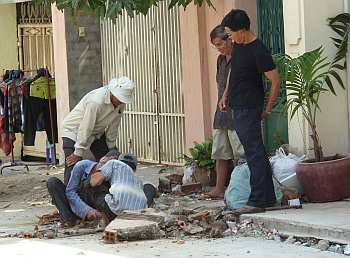 This is a house on the other side of the street. The occupants don't seem to have a particularly great amount of money so it's only a guess why the workmen put a curb in front of that home. This side of the street is important because the lone, inadequate sewer lies directly beneath the workers. |
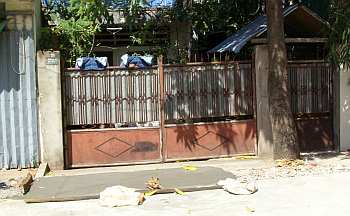 8 June 2008 I had hopes that the city who tore up our street would actually finish the job with proper curbs and sewers, but I believe that was too much to ask. Our neighbor across the street just had someone put down concrete in front of his gate into his house compound.
|
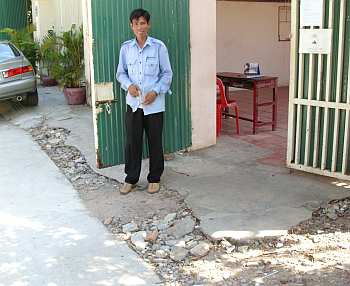 Now it looks like DDP will have to do the same. I'm checking to find someone who can do a simple but reliable concrete job on this entranceway into our office. That is Ura, one of our guards, at the gate. Perhaps most people in Cambodia would just buy a bag of concrete and do the job themselves but I'd really like the driveway to look right and last a long time. |
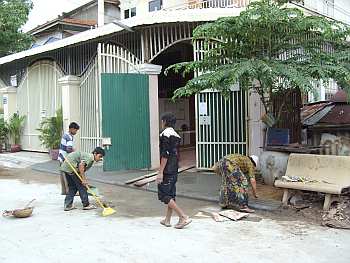 12 June 2008 Mirabile dictu! For those of you who studied Latin but don't remember this famous phrase from The Aeneid, it means "It's marvelous to say!" or, more colloquially, "Who'd athunk it!" Suddenly this morning a little old guy came into our entranceway, plopped down a bag of cement, and took off. I went outside to see what was happening and found our landlord who told us a crew was coming to repair the concrete entrance into our office property.
|
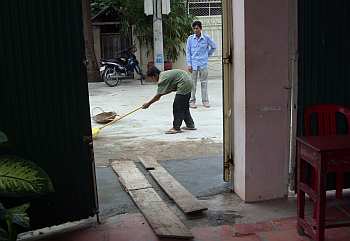 Within a couple hours, several young men and a middle-aged woman had taken away the broken up pavement and replaced it with a new layer of concrete and even pre-fab curb stones! It looks good! Here one of the young men sweeps up after the job was completed. |